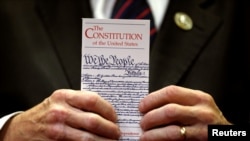Article Two of the United States Constitution establishes the executive branch of the federal government, which carries out and enforces federal law.
The executive branch includes the President, the Vice President, the Cabinet, and other U.S. government entities. Article Two enumerates the powers bestowed on the office of the President and recognizes the President as the head of the executive branch, as well as the nation's head of state and head of government.
The method of electing the President and Vice President through the Electoral College was first established by Article Two and later refined by the Twelfth Amendment.
The president is the Commander in Chief of the United States Armed Forces. He or she has the power to make treaties with the advice and consent of a two-thirds majority of the Senate. To administer the federal government, the President commissions all the offices of the federal government as Congress directs. The President is required see that the laws are faithfully executed. The President reports to Congress on the State of the Union, and recommends "necessary and expedient" national measures. The President may convene and adjourn Congress under special circumstances.
Section 4 of Article Two provides for removal of the President and other federal officers. The U.S. Congress may impeach, or charge with misconduct, and remove the President for treason, bribery, or other high crimes and misdemeanors. The impeachment process begins when a simple majority of the members of the House of Representatives present vote for each article of impeachment or the resolution as a whole. The proceedings then move to the U.S. Senate where they take the form of a trial. A two-thirds majority is required for conviction. By this means, the President and U.S. official are accountable to Congress and the American people.
The most important function of the President is expressed in the inauguration oath. Every President is required to swear that he or she will, to the best of their ability, “preserve, protect and defend the Constitution of the United States." Thus the Constitution insures that the United States continues to have what,framer of the Constitution and the Second President, John Adams, called “a government of laws and not of men.”














